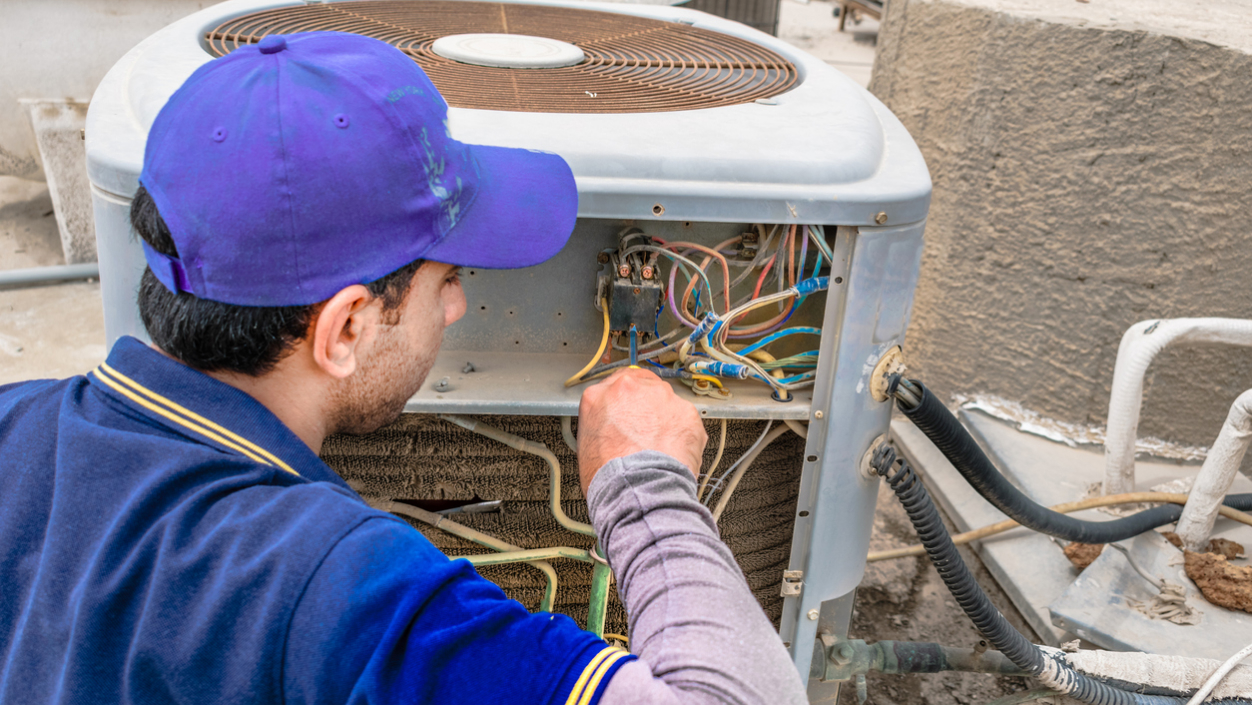HVAC Mechanics and Asbestos Exposure
HVAC mechanics’ exposure to asbestos is the result of working directly with HVAC products containing asbestos and working in residential and public buildings that were built with asbestos-containing materials.

How Are HVAC Mechanics Exposed to Asbestos?
Heating, ventilation and air-conditioning (HVAC) systems are maintained by HVAC mechanics, and this occupation is considered at risk of asbestos exposure because it required workers to handle asbestos products. Asbestos was used in HVAC equipment because it provided strength, durability and heat-resistance.
When old ductwork is cut, sanded, broken or disturbed in any way, asbestos fibers can be released into the air and inhaled by workers. HVAC mechanics also are exposed to asbestos during normal system maintenance. They must frequently change filters and check furnaces. When mechanics open compartments and panels to perform these tasks, they can disturb any asbestos that has settled in the space. Often, this debris also contains asbestos fibers.
Additionally, HVAC mechanics working on buildings built before 1980 may be at risk of asbestos exposure. Repairs can often disturb asbestos in insulation, drywall, flooring and ceiling tiles, steam or water piping and furnace ducts. The inhalation of asbestos fibers can lead to serious health problems. Asbestos exposure is the primary cause of mesothelioma, and it also can cause asbestosis and asbestos-related lung cancer.
Asbestos Products Associated with HVAC Mechanics
HVAC mechanics had to directly handle asbestos-containing ductwork connectors. They were also exposed when they cut or damaged old building materials that contained asbestos.
HVAC mechanics may be exposed to a variety of asbestos products, including:
- Adhesives: Asbestos-containing adhesives, joint compound, spray-on materials and mastic products were used as sealants around heat sources in attics and basements where HVAC mechanics work. HVAC workers had to sand away adhesives on old equipment to make repairs, which can release asbestos fibers into the workspace.
- Asbestos Ductwork: Ductwork connectors used to contain asbestos because it provided strength, flexibility and resistance to heat. HVAC mechanics directly handled this product when installing and making repairs. Asbestos paper insulation was sometimes wrapped around ductwork as well.
- Asbestos Insulation: Asbestos was often used as insulation in and around many products, including ductwork, steam or water piping, boiler surfaces, furnace ducts and baseboard heat registers. These products are often in areas of buildings where heating, ventilation or air conditioning units are stored.
- Asbestos Walling, Flooring and Ceilings: Drywall, flooring, ceiling tiles and firewall bricks contained asbestos, and HVAC mechanics sometimes had to cut away at these materials to access HVAC equipment.
- Asbestos Cement Pipes: Asbestos cement was used to make steam and water pipes. Pipe tape and wrap insulation around pipes also contained asbestos. HVAC workers may brush up against old asbestos pipes and release toxic fibers.
- Asbestos Furnaces: Asbestos was used inside furnaces as a liner, and different types of asbestos insulation, such as asbestos rope and packing, was used outside furnaces to contain heat. HVAC workers who repaired furnaces were at risk of asbestos exposure.
Manufacturers Who Made Products HVAC Mechanics Used
Manufacturers of asbestos-containing products and building materials have been sued by HVAC mechanics who developed mesothelioma and other asbestos-related diseases.
Manufacturers who made asbestos products HVAC mechanics were exposed to include:
- W.R. Grace & Co.: Grace’s Zonolite brand of insulation and building materials contained asbestos. HVAC mechanics were most likely to encounter Zonolite attic insulation, Monokote fireproofing cement and acoustical plaster.
- Johns Manville: JM made many different types of asbestos building materials that HVAC workers worked around including asbestos cement, panels, boards, insulation and caulking putty.
- Rich Tex Inc.: This company made asbestos-containing joint compound, spray texture and acoustical ceiling spray that workers used when making repairs on and around HVAC equipment.
- Bestwall Gypsum: Bestwall Gypsum made asbestos-containing adhesives, plaster and joint compounds that HVAC mechanics used when making drywall repairs around HVAC equipment.
- Gold Bond: Gold Bond made asbestos-containing wallboard, spray texture, stucco, plaster, adhesive, cement and joint compound that HVAC workers used to repair any damage to building materials around HVAC equipment.
- Kaiser Gypsum Company Inc.: This company made stucco materials, joint compounds for wallboard and radiant heating components, and texturing paint with asbestos that HVAC workers used when repairing HVAC equipment and surrounding building materials.
- Sprinkmann Insulation: Sprinkmann made asbestos insulation that was used around steam pipes that HVAC workers encountered when making repairs.

Get help finding a top attorney who can get you the compensation you deserve.
Get Help NowHVAC Mechanics and Mesothelioma
Scientific studies have documented an increased risk of asbestos-related illness in HVAC mechanics and examined the risk of asbestos exposure when working on HVAC equipment. According to a 2022 report by the European Commission, over 70,000 workers died in 2019 from past exposure to asbestos.
- A 2017 article in EC Pulmonary and Respiratory Medicine analyzed asbestosis deaths in the U.S. from 1970 to 2014. The data showed that HVAC mechanics are over four times more likely to die of asbestosis than the general population. The only cause of asbestosis, which is a progressive respiratory disease, is exposure to asbestos.
- A 1992 study analyzed whether asbestos-containing materials found in older HVAC systems were released from the system. Researchers confirmed that asbestos fibers are released when HVAC systems are installed, maintained and repaired.
Mesothelioma is a rare type of cancer that is primarily caused by asbestos exposure. Exposure to asbestos also causes lung cancer, ovarian cancer, laryngeal cancer and asbestosis. If you’re a former HVAC mechanic and develop any respiratory or digestive problems, tell your doctor about your asbestos exposure history and request a cancer screening. Diagnosing and treating these conditions early improves treatment outcomes. Make sure to find a doctor specializing in your diagnosis to access the best treatment.
Legal Options for HVAC Mechanics Exposed to Asbestos
HVAC workers have successfully sued manufacturers using asbestos in products for compensation to cover medical bills, lost wages and other expenses related to their diagnosis.
- In 2017, a Pennsylvania jury ruled in favor of asbestos defendants in a mesothelioma lawsuit filed by the widow of an HVAC mechanic who died of mesothelioma. A total of 11 defendants were included when the trial began, and only five remained when the jury issued its decision, indicating the other defendants may have opted to settle with the plaintiff.
- In a wrongful death lawsuit against Sprinkmann Insulation in Wisconsin, formerly Sprinkmann Sons Corp., a man who worked as a HVAC contractor for the company developed mesothelioma and died. The disease was related to the significant amount of asbestos he was exposed to after decades of working in various industrial locations for the company. A jury awarded the man’s family $1.5 million in 2012.
- James Morrison received a $325,500 verdict in 2008 from a lawsuit against his former employer, Copeland Refrigerator Company. Morrison worked as an HVAC mechanic for the company in the 1970s and 1980s and was exposed to asbestos from refrigeration compressors. He said this led to the development of his mesothelioma cancer. A jury found Copeland responsible for 12.4% of the damages suffered by Morrison.
It is important to find an experienced mesothelioma lawyer to handle your legal claim. They have the training, tools and background to properly handle your case to maximize compensation. You may qualify to file multiple asbestos trust fund claims in addition to a personal injury lawsuit.
If you’ve lost a loved one to mesothelioma, you may be eligible to file a wrongful death lawsuit to recover compensation for medical and funeral expenses.
Recommended Reading


